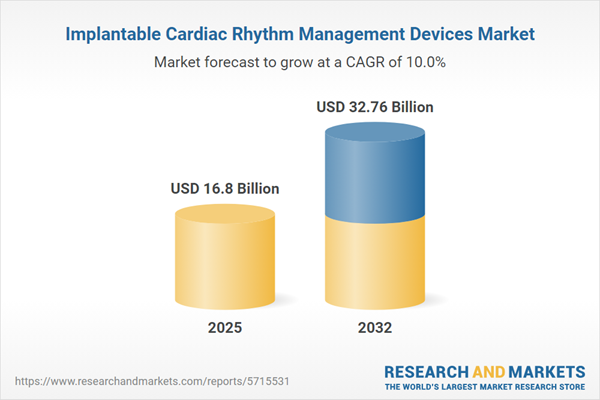Speak directly to the analyst to clarify any post sales queries you may have.
The implantable cardiac rhythm management devices market is evolving amid swift technological advancements, complex regulatory changes, and a renewed focus on operational excellence. Strategic choices made now will shape organizations’ capacity to meet emerging clinical needs and secure competitive advantage in cardiac care innovation.
Market Snapshot: Implantable Cardiac Rhythm Management Devices Market
In 2024, the implantable cardiac rhythm management devices market reached a value of USD 15.23 billion, with projections rising to USD 16.80 billion in 2025 and expected growth to USD 32.76 billion by 2032, resulting in a CAGR of 10.04%. This expansion is driven by broad clinical acceptance, new real-time digital health technologies, and sustained demand for next-generation solutions. Widespread remote monitoring adoption, differentiated competitive strategies among market entrants, and the growing use of adaptive devices leveraging digital insights are enhancing efficiency for providers and delivering more individualized care for patients.
Scope & Segmentation
- Device Type: Encompasses cardiac resynchronization therapy (CRT) devices in both pacemaker and defibrillator configurations, as well as implantable cardioverter defibrillators (ICDs) and an array of pacemakers designed for comprehensive arrhythmia management and advanced heart failure therapy.
- Technology: Includes biventricular, single-chamber, and dual-chamber systems, facilitating personalized care and enabling clinicians to tailor interventions for diverse patient profiles and complex cardiac cases.
- Component: Incorporates atrial, ventricular, and coronary sinus leads alongside pulse generators, underpinning robust device function engineered for precision, reliability, and long-term clinical performance in rhythm management.
- End User: Spans ambulatory surgical centers, cardiac clinics, and acute care hospitals, broadening the availability of advanced rhythm management solutions to meet various procedural and critical care requirements.
- Age Group: Covers both adult and pediatric patient populations, supporting diverse approaches to disease management and enabling early intervention strategies for specialized cardiac therapies in younger patients.
- Regions Covered: Includes North America, Latin America, Europe, Middle East & Africa, and Asia-Pacific, each reflecting unique regulatory frameworks and healthcare practices adapted to local market demands.
- Leading Companies: Features major innovators such as Medtronic plc, Boston Scientific Corporation, Biotronik SE & Co. KG, MicroPort Scientific Corporation, Abbott Laboratories, LivaNova PLC, and Lepu Medical Technology (Beijing) Co., Ltd., contributing to a dynamic competitive environment and expanded international reach.
Key Takeaways for Senior Decision-Makers
- Remote monitoring supported by advanced analytics strengthens patient engagement and allows clinicians to streamline workflows, leading to enhanced care coordination through connected digital platforms.
- Successful investment now relies on evaluating value-based technologies and development pipelines, as changing care initiatives and reimbursement policies reshape market entry and growth strategies.
- Increasing regulatory flexibility supports accelerated introduction of new device technologies, enabling organizations to maintain agile product delivery while adhering to stringent patient safety requirements.
- Modernized supply chains that incorporate regional manufacturing and digital production methodologies provide resilience and mitigate exposure to potential trade or logistics disruptions.
- Adoption of interoperable solutions and minimally invasive procedures improves continuity of care across inpatient and outpatient environments, optimizing case management and operational efficiency.
- Thoughtful segmentation by device, patient age, and healthcare environment enables more precise targeting of emerging trends in both adult and pediatric cardiac rhythm management.
Tariff Impact & Supply Chain Dynamics
Recent tariff measures in the United States are prompting companies in the implantable cardiac rhythm management device sector to adapt their sourcing and production strategies. The emphasis is now on establishing regional manufacturing hubs and exploring digital production models, with many manufacturers evaluating alternative materials to safeguard operational margins. Strengthening relationships with domestic suppliers and piloting new production techniques has become increasingly important to maintain delivery schedules and buffer against market instability. Flexibility remains essential, as evolving international trade regulations continue to influence supply chain decisions and competitive positioning.
Methodology & Data Sources
Research for this report utilizes a comprehensive approach, combining primary interviews with electrophysiologists, device engineers, procurement experts, and regulatory officials. Supplemental secondary sources include peer-reviewed literature, regulatory documents, market registries, and in-depth company reporting, with multi-analyst validation ensuring the integrity and reliability of findings for senior decision-makers in the implantable cardiac rhythm management devices market.
Why This Report Matters
- Empowers leadership teams to align strategies with technology advancements and evolving clinical pathways in the cardiac device space.
- Clarifies how tariffs, regulatory shifts, and the digital transformation landscape affect operational and investment planning.
- Delivers detailed segmentation and competitor insight to guide opportunity assessment, market growth initiatives, and partnerships across global regions.
Conclusion
Organizations that adopt agile strategies and nurture ongoing innovation are positioned to meet future market needs and improve patient outcomes as the implantable cardiac rhythm management devices sector continues its transformation.
Additional Product Information:
- Purchase of this report includes 1 year online access with quarterly updates.
- This report can be updated on request. Please contact our Customer Experience team using the Ask a Question widget on our website.
Table of Contents
3. Executive Summary
4. Market Overview
7. Cumulative Impact of Artificial Intelligence 2025
List of Figures
Samples

LOADING...
Companies Mentioned
The key companies profiled in this Implantable Cardiac Rhythm Management Devices market report include:- Medtronic plc
- Boston Scientific Corporation
- Biotronik SE & Co. KG
- MicroPort Scientific Corporation
- Abbott Laboratories
- LivaNova PLC
- Lepu Medical Technology (Beijing) Co., Ltd.
Table Information
| Report Attribute | Details |
|---|---|
| No. of Pages | 188 |
| Published | October 2025 |
| Forecast Period | 2025 - 2032 |
| Estimated Market Value ( USD | $ 16.8 Billion |
| Forecasted Market Value ( USD | $ 32.76 Billion |
| Compound Annual Growth Rate | 10.0% |
| Regions Covered | Global |
| No. of Companies Mentioned | 7 |









